#Queen said Prince Philip’s death last year
Text

3 notes
·
View notes
Text
This is random as fuck but I'm thinking about Henry's royal surname
So I happen to be a bit of nerd when it comes to British royalty, I literally don't have a reason for that except it's interesting to me
I actually really appreciated changing movie Henry's surname, until I found out they're real royal houses and started wondering about RWRB's history
In the book it was Mountchristen-Windsor, obviously modelled after irl royal family Mountbatten-Windsor, although Mountbatten was derived from the German Battenberg family from the Queen's husband, Prince Philip of Greece and Denmark, which is also an actual place in Germany. As far as I can tell Mountchristen is entirely fictional?
Book Henry mentioned having a Great Uncle who abdicated because he was a Nazi, which is irl Duke of Winsdor, Queen Elizabeth's uncle (although the reason he stated was for love), so I think? That the lineage was the same until at least that generation. But Queen Mary, Henry's grandmother said she's been serving the country for 47 years, and Princess Catherine, Henry's mother is 60 years old in 2020, born in 1960, approximately the same age as Prince Andrew, Queen E's third child. Henry was born in 1997, and Prince William was born in 1982. So the generational year gap changes there: for RWRB there's four generations, while irl there are five generations in 2020.
So a bit of math here, assuming that the Duke of Windsor's abdication is the same as the real world, which is 1936, so the lineage is the same up to 1936. The book takes place in 2020, so Queen Mary ascended to the throne in 1973, 37 years after the Duke of Windsor's abdication, a reasonable amount of years for one monarch's reign. So that monarch is where things went differently. As for how it went differently...yeah I don't fucking know my brain cells ran out.
But Movie Henry's royal family name is Hanover-Stuart, two actual houses of royalty: King James IV&I of M&G belongs to the House of Stuart (so what the fuck Nick another coincidental connection between your characters) with Anne, Queen of Britain being the last reigning monarch of the House of Stuart (after her death her cousin George of Hanover inherited the British Throne); Queen Victoria was the last reigning monarch of the House of Hanover (her children belonged to the house of her husband: the House of Saxe-Coburg and Gotha, which was later renamed Windsor during WWI). In our world, the House of Stuart went extinct in 1807, while the House of Hanover still has living members in Europe, granted no longer in direct relations to the British monarchy
So what I'm wondering if for movie verse, where the history of the British royal family changes for Henry to have this different surname:
For Hanover, it's possible that for the universe, Queen Victoria's children still bore her name of Hanover and didn't change it during the war, so the rest of the lineup to Henry kept Hanover. But I cannot for the life of me imagine where would Stuart come from given that the line broke off there
... yeah I don't know what point I'm trying to make or what conclusion I drew, but I used up an hour going down this rabbit hole. If my dad knew I was doing math for this instead of doing my calculus homework he'd kill me but whatever
Also I bet neither Casey nor Matthew actually thought this deep about such a minor thing this is how bad my rwrb brainrot is if we don't get something soon I'm gonna go stir crazy
#rwrb#red white and royal blue#rwrb movie#nicholas galitzine#henry fox mountchristen windsor#henry hanover stuart fox#firstprince#rwrb thoughts#rwrb rambles#history#british history#what the fuck is wrong with me
53 notes
·
View notes
Text
"In the mammoth royal love in we are enduring, we are told about the Queen’s cordial relationship with numerous PMs. But not Gough Whitlam. That would upset our colonial mind set. We try and shut out the Queen’s implausible and misleading denial on the Whitlam sacking.
It beggars belief that the Queen did not know that John Kerr was planning to sack Gough Whitlam. She may not have known the detail of the coup in progress, but she knew the substance and so did her family and particularly Prince Charles. But like Lord Nelson she pretends she did not see anything. Nonsense. She is trying to mislead us. That is not surprising for the Queen of Australia who lives in London.
Upper classes do stick together and will break rules and conventions when it suits.
Prince Charles, now King Charles 111 and King of Australia wrote to Kerr after the dismissal, ‘what you did last year was right and the courageous thing to do’
There are many reasons to reject the Queen’s cover-up and the cover-up done on her behalf. Importantly the Queen is formally responsible for what her staff do in her name. Her Private Secretary, Martin Charteris was her alter ego. We also know that the Queen was extraordinarily close to Charteris. ..." continue

Why has there been so little said about this since the queen's death? Or in general?
I'm not sure whether I'd just forgotten or never knew about this.
Gough Whitlam was apparently the first PM (1972-1975) to actually start restoring land rights to indigenous "Australians" after decades of false promises by his predecessors.
He came to power in 1972, ending decades of Conservative rule, and proceeded to abolish the death penalty and university fees, establish legal aid, and finally bring to an end the racist White Australia policy which had virtually banned non-white immigrants. And so much more.
After less than 3 years, Whitlam was sacked by the queen through the Governor-General John Kerr, in what seems often to be referred to as a coup. It is also widely suspected that the CIA was involved in these events, as they were closely tied to Kerr and others in the political right.
502 notes
·
View notes
Text
Princess Anne’s visit reinforces Sri Lanka-UK bonds - Plaudits for hard work and modest outlook
Published 14th January 2024
By Pramod de Silva
The British Royal Family is changing their outlook following the demise of Queen Elizabeth II and amidst increasing calls for truncating or even abolishing the monarchy.
Indeed, gone are the days when the British Empire was known collectively as a region where the “Sun never sets” as its colonies were located all over the globe, from Sri Lanka (then Ceylon) to South Africa. Now there are only a very few British protectorates left, including the Falklands Islands. All others have either become Dominions with King (Charles III) as the titular Head of State (examples include Canada and Australia) or Republics with no sovereign ties to the British King, such as Sri Lanka and India.

A humble Princess Anne carried her own bags off the plane as she arrived at the Bandaranaike International Airport in Katunayake with her husband Vice Admiral Sir Timothy LaurenceA humble Princess Anne carried her own bags off the plane as she arrived at the Bandaranaike International Airport in Katunayake with her husband Vice Admiral Sir Timothy Laurence.
Yet, the British Royal Family maintains a measure of popularity in the so-called Commonwealth Countries, which are former colonies of Britain, even if their fame has taken a hit in the UK itself particularly following the death of Princess Diana, and the separation of Prince Harry and his wife Meghan Markle from royal life. The couple has since been living in California, USA.
Queen Elizabeth II’s visit
Sri Lankans, for whatever reason(s), do have a soft corner for the British Royal Family, in spite of the mixed colonial legacy in the country. This was evinced when Queen Elizabeth II arrived here for the first time in 1954. This visit was significant for two reasons. The first was that Sri Lanka hadsaman gained Independence from Britain just six years earlier, in 1948. And Sri Lanka was still a Dominion back then.
The second was that this was one of the Queen’s first official overseas visits after her Coronation on June 2, 1953. She wore her Coronation Frock at one of the events in Colombo during this tour. She would go on to occupy the Throne for nearly 70 years. Her next visit to Sri Lanka was in 1981, by which time the country had become a Republic. But judging by the raucous reception she received wherever she and Prince Philip went, her popularity in Sri Lanka was intact.
In between those two visits, the couple became the proud parents of four children – Princes Charles (the present King), Andrew (Duke of York, though now mostly retired from Royal Duties following a string of scandals), Edward (Duke of Edinburgh) and Princess Anne, now known officially as Princess Royal. She thus happens to be the only daughter of Queen Elizabeth.
It is no secret that Princess Anne is the sibling closest to King Charles, ever-ready to steady the ship amidst the turbulent storms that the Royal Family faced in the years following the tragic death of Princess Diana in Paris in 1997. Her scandal-free life and easy going nature had endeared herself to Royal fans all over the planet.

This might explain the buzz surrounding last-week’s official visit of Princess Anne to Sri Lanka to mark 75 years of diplomatic links between the two friendly countries. Given the revolving door that is Number 10, one cannot imagine a better ambassador to mark this occasion than apparently someone from Buckingham Palace – and the hardest working member of the British Royal Family at that. Princess Anne has earned that moniker from the press thanks to her non-stop work for good causes around the world.
A royal expert has explained why the Princess Royal was chosen as the first member of the family to go away in 2024, as she was praised as being “invaluable” to King Charles. Richard Fitzwilliams said: “Princess Anne is an example of what the public most admire in a working royal, she is dedicated, conscientious and prefers a low profile and no fuss.”
First-ever Royal visit for 2024
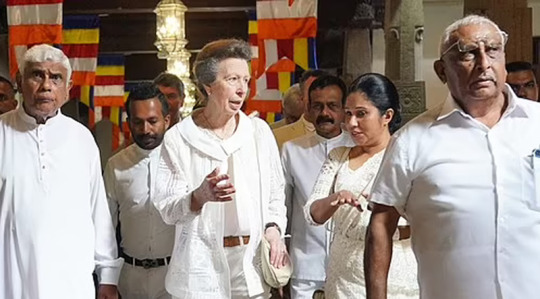
Princess Anne began the second day of her Sri Lanka tour with a visit to the Sri Dalada Maligawa (Temple of the Sacred Tooth Relic) in KandyPrincess Anne began the second day of her Sri Lanka tour with a visit to the Sri Dalada Maligawa (Temple of the Sacred Tooth Relic) in Kandy
In fact, her trip to Sri Lanka gained international media attention due to several reasons, with magazines such as Hello! And People devoting multiple pages to the coverage, not to mention all mainstream British newspapers. After all, this was the first-ever overseas visit by any Member of the Royal Family for 2024. Princess Anne is no stranger to Sri Lanka, having visited the country previously in 1995, as a patron of the Save the Children Fund.
The media were quick to highlight the fact that Anne (73) and her husband Vice Admiral Sir Tim Laurence (68) flew on a commercial airline to Colombo, whereas they could have requested a Government Airbus A330 or other aircraft from the Royal Air Force (RAF). In fact, SriLankan Airlines, the only carrier which flies directly between London (LHR) and Colombo (CMB) could not hide its delight, posting on X under the headline “A Service Fit for a Royal”.
A SriLankan Airlines post said: “We are delighted to welcome onboard Her Royal Highness (HRH) the Princess Royal on her journey from London to Colombo on a three-day official visit to mark 75 years of diplomatic relations between Sri Lanka and the UK. It is truly an honour to extend Her Royal Highness and the delegation our inherent Sri Lankan warmth and hospitality, thereby presenting the first taste of our island home through our service. We thank the HRH for honouring us with her presence onboard and choosing us for the journey.”

Royal commentators and observers were also delighted to note that the couple carried their own bags, both at the points of embarkation and disembarkation. Princess Anne and Sir Tim’s down-to-Earth nature was displayed by them carrying their own bags onto the flight, the commentators said. One eagle-eyed royal writer even noted that one of her bags was from the French brand Longchamp’s La Pliage Line, costing just 115 Sterling Pounds, at a time lesser mortals like to show off bags from the likes of Louis Vuitton costing thousands of pounds or dollars.
A welcome ceremony at the airport saw the two Royals greeted by dancers, music, Union Jack flags and a red carpet. Princess Anne, sporting sunglasses, was received by dignitaries including the British High Commissioner Andrew Patrick and Minister of Foreign Affairs Ali Sabry, PC.
Princess Anne and Sir Tim kicked off their engagements right away, heading first to the MAS Active Factory near the Airport, one of the largest apparel tech companies in South Asia and identified by the UK Fashion and Textile (UKFT) Association as an important Sri Lankan partner. As President of the UKFT, the Princess Royal met staff and toured the facility to hear more about their innovative designs and partnerships with leading UK brands.
Princess Anne, Princess Royal signs the golden book after she arrives for a three-day official visit to Sri Lanka at the BIA in KatunayakePrincess Anne, Princess Royal signs the golden book after she arrives for a three-day official visit to Sri Lanka at the BIA in Katunayake.
Letter from King Charles
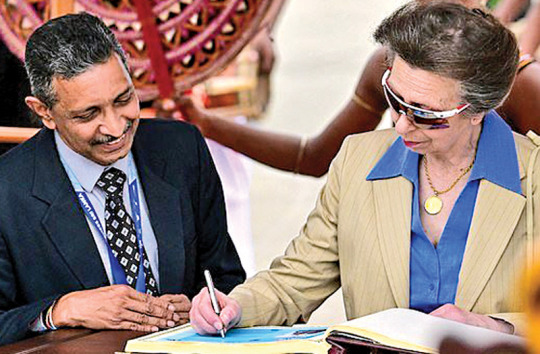
The couple also met President Ranil Wickremesinghe and Prof. Maitree Wickremesinghe at the President’s House. Her brother King Charles had outlined “considerable challenges” that the world is facing in a letter delivered by Princess Anne to President Wickremesinghe during this meeting.
The Royal Couple also got the opportunity of meeting former President Chandrika Bandaranaike Kumaratunga on this occasion. She was the incumbent President when Princess Anne last toured the island in 1995. Royal watchers praised the Princess’s modest outfit worn to this important event. Hello! Magazine described her outfit in this manner: “Putting on a colourful display, the Princess Royal asserted her sartorial prowess in a ravishing red shift dress adorned with blooming pastel flowers. For an additional pop of colour, the royal added a berry-red lipstick, balancing her ensemble with a draped cream scarf and white gloves.” Another royal watcher said that her white gloves worn at the event were a subtle nod to the legacy of her mother.
Princess Anne, with her lifelong affinity to the Save the Children Fund, also took time off her busy schedule of meetings to visit its offices in Colombo and inquire into their programs in Sri Lanka. After unveiling a plaque commemorating the 50th anniversary of Save the Children working in Sri Lanka, she gave an impromptu speech to staff and guests at the charity’s Colombo HQ.

Princess Anne said: “It’s a real pleasure to return to Sri Lanka and the chance to visit Save the Children’s (headquarters) and underline the fact you have been doing extraordinary work here for 50 years.’ And I know, because when I came before it was slightly different, things have changed a lot. But the very fact that you are here and seen as valuable partners to the Government and the departments – that says a lot for what you’ve achieved…So a big thank you to all those who have been part of that journey, thank you all very much.” She also visited the Lady Ridgeway Hospital (LRH) in Colombo.
Princess Anne paid her respects to the Fallen Heroes of World Wars when she laid a wreath in their memory in Colombo, during her first visit to a Commonwealth War Graves Commission (CWGC) cemetery in the Jawatta area as the organisation’s President. They also visited the nearby Vajira Pillayar Hindu Kovil, where Sir Tim dashed a coconut to ward off bad luck. Chief Priest Sachithanantha Kurukal went into the shrine to conduct the pooja as Princess Anne and her husband watched, and they later toured the temple viewing the many shrines to Hindu Gods.
The Royal Couple then left for Kandy, where they paid homage to the Sacred Tooth Relic of the Buddha at the Sri Dalada Maligawa. Dressed in white, Princess Anne was ushered into an inner sanctum, reserved for the temple’s most important guests, to make her offering to the Sacred Relic in private.
Princess Anne engaged in a friendly conversation with Former President Chandrika Bandaranaike KumaratungaPrincess Anne engaged in a friendly conversation with Former President Chandrika Bandaranaike Kumaratunga

Later, the couple travelled to Jaffna, where they toured the famous Jaffna Public Library, which was burnt down by mobs in 1981 and then rebuilt to reflect its former glory. The couple toured the library “where they heard of its significance to the community and met key figures from the fields of education, arts and culture,” said the British High Commission in Sri Lanka. Andrew Patrick, British High Commissioner to Sri Lanka, called the building “a landmark of great significance”. “This important moment marks the first visit by a member of the Royal Family to Jaffna,” he added.
The library was one of the largest libraries in Asia and housed over 97,000 unique and irreplaceable palm leaves books (ola), manuscripts, parchments, books, magazines and newspapers, before its destruction in 1981.
The couple had several other engagements in Sri Lanka before they flew back to the UK after a highly successful visit, which reinforced UK-Sri Lanka ties. Several more events will be held in 2024 to mark this milestone.
Princess Anne’s Sri Lanka visit is her second official engagement of this year, having returned to duties on January 4 to attend the Oxford Farming Conference.
The King and Queen are also set to fly overseas later this year. The couple are expected to visit Canada in May, before flying to Australia, New Zealand and Samoa in October.
As for the Prince and Princess of Wales, they too will be preparing to return to Royal Duties in the coming week, which comes after the family celebrated Princess Kate’s 42nd birthday on Tuesday January 9.
#a lovely summary of an excellent trip 💗#princess anne#princess royal#tim laurence#timothy laurence#sri lanneka
25 notes
·
View notes
Text
I...am back?
Hello!
It's been a while (almost two years, to be exact) since I came around here. First of all I apologise for disappearing from the face of Tumblr out of the blue, and many many thanks to the concerned people dropping asks on my inbox! As I've said to CC (@celticcrossanon) in my new years' greeting, I am honestly still mourning both The Queen and Prince Philip and at this point, I am accepting that it will never go away, nor will it ever stop from permeating everything. The grief is still there, and while not as fresh as it was a year ago, it is still there and still permeates every and all energy I pick up every time I pick up my cards. I don't know when I will be able to read again, which was the main reason I dropped off Tumblr because I am here to read and if I can't read, I didn't see the point of keeping the blog alive. But I am back, even if I still can't read.
Second was that my life became very hectic in the last two years. I moved job twice, got proposed to, and am having a wedding preparation underway. I have to take care of my affairs transitioning from singleness into married life, and it is more tiring than I expect it to be. I feel like a year wasn't enough to prepare for the marriage!
And third, while I cannot promise when I will be able to read again, I do have some questions I want to ask my cards, especially pertaining to Frederik and Mary and the alleged cheating rumours. I also want the truth of children to come out once and for all, and I kind of want to ask my cards several questions I've asked before in the past, particularly about the divorce.
Once again, I am back! I will not be online as often as before, but I will still be here, lurking around, and will see if I can pick up my cards again.
Edit: I will be clearing my inbox! Feel free to drop into my inbox to chat, ask, or anything (I am also incredibly behind the latest news, so feel free to info dump me!). For the time being I also accept reading requests, but will make no promise on when or whether I will get into it. My rules still apply (no personal readings, no celebrities reading, no timing, no pregnancy/death readings).
21 notes
·
View notes
Note
sorry for the following solemn question, was there any story the day bertie died? the only one i that i know is that lilibet didn't know until hours later when philip broke the news to her because they were in kenya. what about queen mary, queen mum, and margaret?
this come to my mind after watching https://www.youtube.com/watch?v=qHXla__FEiY the way the queen mum actress runs while crying his name just broke my heart.
Thanks for your question - and really sorry it took me ages to get back to you 😣. I've written a little bit about how Margot, May and Elizabeth were all affected by Bertie's death, and I hope I'm answering this correctly!
Princess Margaret
Princess Margaret was at Sandringham when her father died. She recalled hearing him laugh 'heartily at a joke he had just heard' and then go happily to bed at 10:30pm. When she learned of his passing in the morning, she was absolutely distraught. It is said that she was even prescribed sedatives to help her sleep at night, and Christopher Warwick wrote (in his 2017 biography, Princess Margaret: A Life of Contrasts) that she would frequently weep and cry out, 'Why did he have to die so young?'
A couple of months after Bertie’s death, Margaret wrote to a family friend, 'He was such a wonderful person, the very heart and centre of our happy family. Everything seemed to come from him and no-one could have had a more devoted and thoughtful father. He was always so very much alive so that at this lovely Easter time he doesn’t feel so very far away and one is comforted by all thoughts of happiness for him and his love for us all.' Even the fact that Margaret’s own funeral was held on the 50th anniversary of Bertie's death also shows just how close she held her father in her heart - right until the very end.

The Queen Mother
When The Queen Mother was praised for her courage in getting through her husband’s funeral without crying, she replied: 'Not in private.' In fact, she was so heartbroken after his death that she travelled all the way to Caithness in Scotland to be allowed to mourn alone (I've actually been there and it is *very* remote). This was also the time when she discovered Castle Mey, which she bought to escape to ‘occasionally when life becomes hideous’ - which I imagine was linked to those dark days when she felt the loss of Bertie all over again.
She said in a letter to Queen Mary: 'I flew to his room and thought he was in a deep sleep, he looked so peaceful — and then I realised what had happened.' She also further confided in her mother-in-law, 'I know that you loved Bertie dearly, and he was my whole life, and one can only be deeply thankful for the utterly happy years we had together. He was so wonderfully thoughtful and loving, and I don’t believe he ever thought of himself at all… I cannot bear to think of Lilibet, so young to bear such a burden — I do feel for you so darling Mama — to lose two dear sons, and Bertie still so young and so precious — it is almost more than one can bear…'
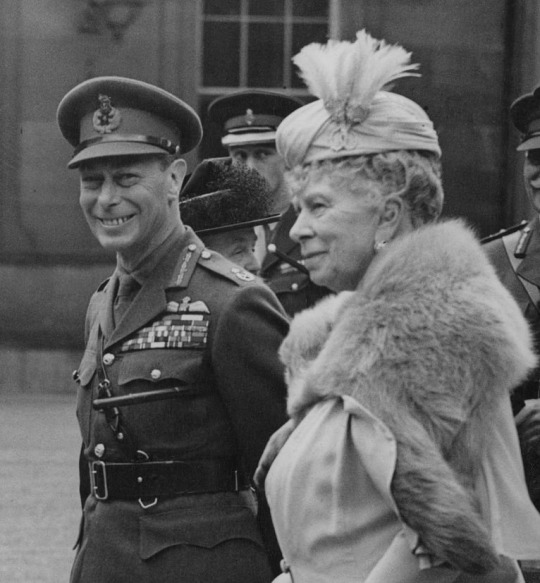
Queen Mary
Having already lost two sons (Prince John at the age of 13, and Prince George in an RAF plane crash just before his 40th birthday), the death of a third child, her beloved Bertie whom she was so close to and so proud of, deeply traumatised her. Queen Mary said to Princess Marie Louise: 'I have lost three sons through death, but I have never been privileged to be there to say a last farewell to them.' Mary herself also remarked that she spent a lot of time talking to her daughter-in-law (the grieving Queen Mother) 'of much that was in our poor tattered hearts.'
Queen Mary’s health was already struggling in the early 1950s, and it wouldn't be surprising that she suffered further after King George VI's death. The sombre photograph of her, Queen Elizabeth and The Queen Mother in mourning dress was taken whilst they were stood at King’s Cross Station in London, awaiting the arrival of Bertie’s coffin from Sandringham for the ‘Lying-in-State' at Westminster Hall. Contrary to popular belief it was not taken on the day of the funeral itself, which she was too unwell (and perhaps too distressed?) to attend.
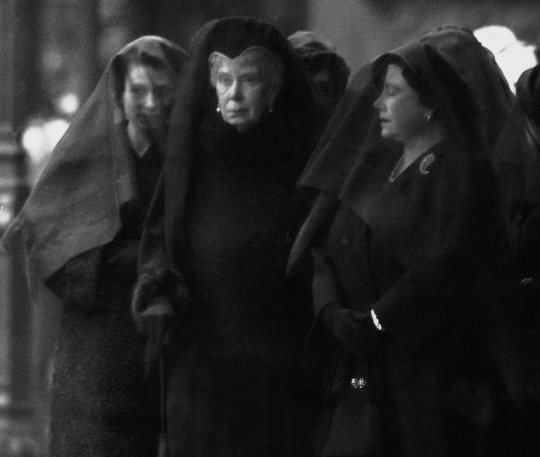
Sources: Princess Margaret: A Life of Contrasts, by Christopher Warwick.
The Queen Mother: The Official Biography, by William Shawcross.
Photos: Getty, National Portrait Gallery.
#king george vi#george vi#god save the king#the british royal family#the monarchy#the british monarchy#the royal family#albert duke of york#the queen mother#queen elizabeth the queen mother#princess margaret#queen mary#queen mary of teck#the king's speech#the house of windsor#long live the king#the british empire#queen elizabeth ii
70 notes
·
View notes
Text
BRF Reading - 6th of May 2023
This is speculation only
Cards drawn on the 5th of May 2023
Question: What does Camilla want from this coronation?

Interpretation: She wants it to be a success for Charles, and she wants it to be over quickly.
Card One: The Knight of Swords.
The Knight of Swords if one of the fastest Knights in the deck, and the energy I am getting from this card is of speed. I have read on this question twice now, and each time I ask the question I hear in my mind the words "I just want it to be over" said in a tone of apprehension. I think that Camilla does want the coronation to be over; she wants it to be behind her instead of in front of her. It can not be over soon enough for her.
I'm not getting any person energy from this card. As an attitude, the Knight of Swords is about being focused on achieving your goal and determined to achieve your goal, so much so that you may overlook the consequences of your actions on others. It can be someone who dives into action without a plan, or someone who focused on a goal only to find that when they achieve the goal, it is not what they want.
The major energy of this card is speed. The minor energy is of someone who is swept up by a process that is leading them towards a life that they don't really want. I think that as much as Camilla likes being in charge and likes being the one driving the action, she has not really sat down and thought about the details of being queen and how that will impact her life, and now that the moment of the coronation is upon her she finds, when it is far to late to change it, that she really does not want to have the life of a queen after all.
The Knight of Swords is a Gemini person. Prince Philip was a Gemini, and he is the predecessor the Queen Camilla. I think that Camilla may have looked at his life and decided that she really does not want to dedicate her last years to supporting the crown like he did. Unfortunately, it is far too late to be pulling out of the coronation now.
Card Two: The Emperor.
This is a major arcana card, and it is the main energy of the spread. Camilla wants Charles to be King. She sees how much it means to him and how he has prepared for the role, and she is looking forward to seeing him crowned and seeing him finally achieve his destiny. She wants the day to be a success for him. The Emperor is the card of the zodiac sign Aries, the first sign of the zodiac, associated with the head, leadership, and the self. Camilla is looking forward to seeing Charles take up the mantle of kingship when he is anointed and crowned.
Card Three: The Seven of Swords.
This is a very odd card to come up. It means deception, trickery , deceit, scheming and being sneaky. In the second reading I did on this question, I got the Moon card, which has a similar energy of deceit. Something about this coronation is either a cover for trickery and deceit, or it is seen by Camilla as being an act of trickery and deceit. There is some sort of deception going on, and I don't know what it is. The card shows Orestes sneaking into the palace to kill his mother, so may be wanting something to metaphorically die? But what? I'm not seeing it.
I pulled a clarifier for this card and I got Judgement, the card of Pluto, the ruler of Scorpio. This again has an image associated with death on it, as we have the god Mercury in the Underworld, in his role as messenger to the Underworld. Pluto tells me that Charles is involved in this, as he is a sun sign Scorpio. However, I am no closer to knowing what 'this' is. The only thing I can think of is that some sort of judgement would stop after the coronation. I don't know. I can't feel the answer and nothing I come up with is making sense - it is not resonating. The next clarifier is the Wheel of Fortune, and the coronation is absolutely going to raise Camilla's fortune/status, so that is no help to me either. Both clarifiers are major arcana cards, so this is important energy, and I just can not interpret it.
Underlying Energy: The King of Cups
This is the card of Charles as a man, and it lies underneath the Emperor, the card of Charles as a king. Camilla's focus on this day is Charles. She want him as a person to feel that they day is a success and that he has had the coronation that he wanted. She is thinking of him as a person and what this day means to him as a person (and not as the nation's King).
Conclusion:
Camilla wants the day to be over. Her focus is on Charles, both as a person and as the King being crowned. She wants the day to go well for him, for him to feel that he has reached his destiny, and she is looking forward to seeing him being crowned king. For herself. there is the sense of being rushed towards a destiny that she does not want. She may have focused on being Queen in the past, she may have planned and/or schemed to be Queen, but now that the coronation is upon her and she has thought about the life she will have as Queen, she realised that, in fact, this is not how she wants to spend the rest of her life. Unfortunately for her, she is being crowned tomorrow whether she wants it or not.
There is some sort of deception or trickery associated with the coronation in Camilla's mind. Either the ceremony is covering up some sort of trickery, or it contains some sort of deception, or she views the ceremony itself as some sort of a trick. I don't know what it is, but there is some sort of trickery/deception/deceit around the coronation that involves Charles and Camilla is aware of this, and she may be involved in it herself.
The dominant energy of this reading is the fast, rational, and sometimes ruthless energy of the Swords suit, the energy of swift and logical thought without any emotion attached to it.
29 notes
·
View notes
Note
“We are talking about the coronation of William 2 weeks later, it gives a narcissistic aspect.”
It’s the press pushing the story - both Roya & Camilla Long not KP.
Relevant quote:
“A source close to the prince said: “He is really thinking, how do we make his coronation feel most relevant in the future? He is mindful of the fact that in 20 years’ time, or whenever his time comes, how can the coronation be modern but also unifying to the nation and the Commonwealth? I think his coronation will look and feel quite different.”
The source added: “Are courtiers sitting at Kensington Palace coming up with a grand plan about what the next Bridge will look like [London Bridge was the codeword for the late Queen’s death, and Forth Bridge for Prince Philip]? No.
“But of course the prince and his team are reflective about the events of last week and it is extremely important to him that it evolves to be relevant whenever it happens.”
You might choose to ask the tarot if royal reporters are actively trying to bring about a republic and the fall of the monarchy.
I don't think journalists are looking for a republican movement, just look at France, we want a 6th republic, seeing an unstable country like ours doesn't make the English want it.
The question of journalists what path the brf will take for this 21st century where social networks are omnipresent where youth is unstable and narcissistic
30 notes
·
View notes
Text
Thread about Joanna of Castile: Part 4: The birth of her children
Juana of Castile had six children. Here is a list of her children and their birthdates:
Eleanor of Austria: Born on November 15, 1498.
Charles V, Holy Roman Emperor: Born on February 24, 1500.
Isabella of Austria: Born on July 18, 1501.
Ferdinand I, Holy Roman Emperor: Born on July 10, 1503.
Mary of Austria: Born on June 18, 1505.
Catherine of Austria: Born on February 14, 1507

Eleanor of Austria was born a year after her uncle's death, the precedent heir to the Spanish throne, John, Prince of Asturias, and four months after her mother's sister's death, Isabella of Aragon, Queen of Portugal.

Clearly disappointed that their first child was a girl, Eleanor, Philip
required Juana to pay for the infant’s nursemaids and attendants.
“The Archduchess may provide for the places in the household of this child because it is a daughter,” Philip asserted. “When God grants us a son, I shall provide for his household.”
God did grant them a son. Juana gave birth to Charles in March 1500, much to Philip’s joy: fireworks raced across the sky, church bells rang, and Philip gave Juana a magnificent and costly emerald as a reward. Their third child, prudently named Isabella after Juana’s mother, was born in July 1501. Because Juana was pregnant with Isabella when news of Prince Miguel’s death and her subsequent inheritance reached her, she and Philip were unable to start for Spain until the autumn of 1501, a couple of months before her twenty-second birthday. For the death of Prince Miguel at Granada on 20 July 1500, five months after the birth of Charles, at Ghent, would convert Juana into heir apparent, and her lost homeland into her future and destination.
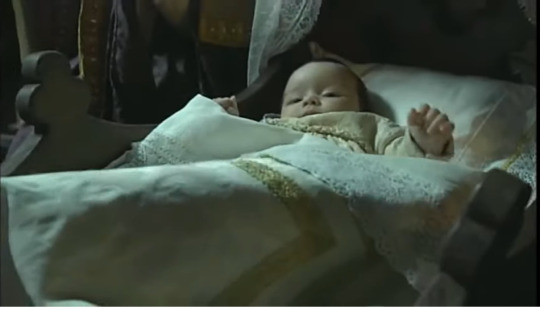

On 15 July 1501, she gave birth, in Brussels, to her third child, Isabella (later queen of Denmark).
A new Spanish envoy, Juan Rodríguez de Fonseca, bishop of Córdoba, reported that Juana seemed eager to serve her parents and was widely thought to be “very sensible (cuerda) and very level-headed (asentada).” Opinion was divided as to whether she should do more to promote Spanish interests.


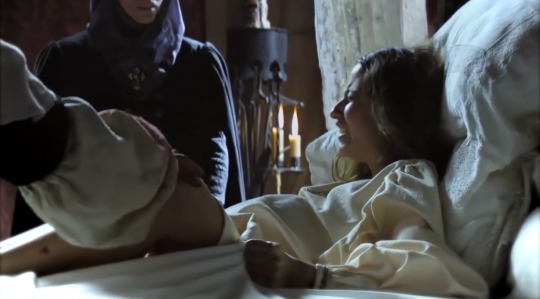

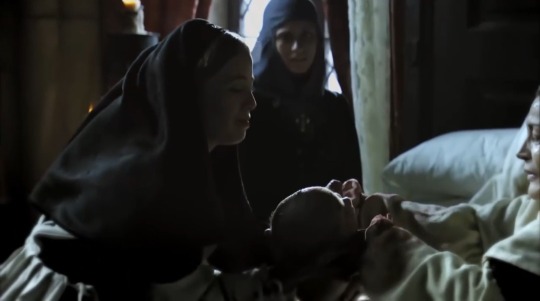
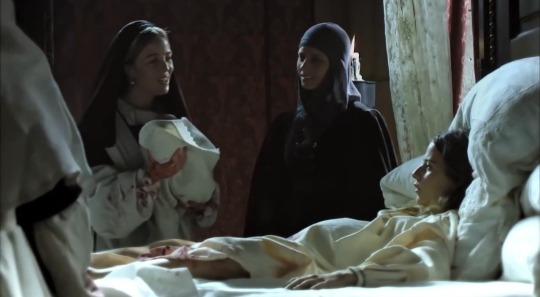



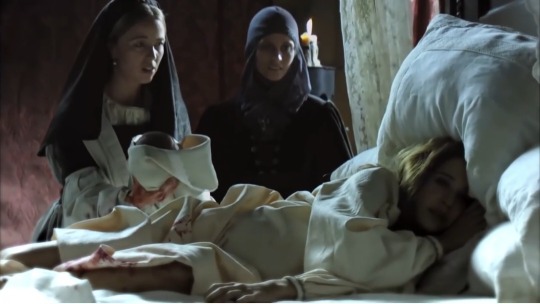
On July 10, 1503, Juana gave birth to her fourth child, Ferdinand I, Holy Roman Emperor, in Alcalá de Henares, Spain.
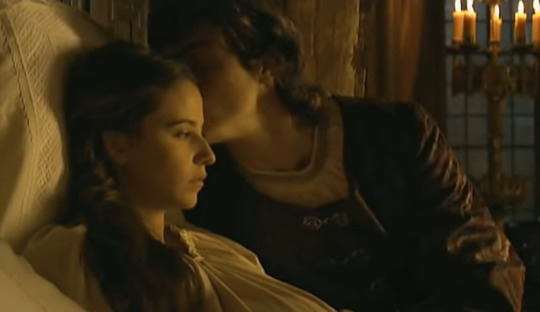
On 15 September, feverish and in pain, the queen gave birth to a
third daughter. Marie, the later Mary of Hungary, was baptized on 20
September at the church of Notre Dame de Sablon. Juana’s seclusion and captivity had long deprived her of her children and, during those rare moments when Philip tried to use them to soften her stance towards him, she had found it unsettling. But she now sought to maximize her time with them. Early in November, Philip left Brussels for Mechelen and Antwerp on the first leg of the second Spanish journey. Juana set out separately, intending to travel through Ghent and Bruges, and, Querini noted, she “has had all the children brought from Malines [Mechelen] and takes them with her to enjoy their company …”

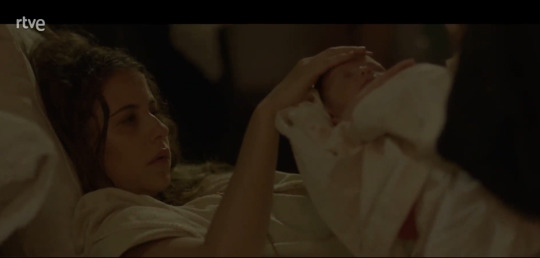

Juana gave birth to her last child and daughter, Catherine of Austria in Torquemada, a town in the province of Palencia, Spain. Catherine was born on February 14, 1507, in the Torquemada Castle. When she was pregnant with her last child, Catherine of Austria, Joanna's mental instability had already worsened. She gave birth while she was in the town of Torquemada, and it is said to have been a difficult and complicated birth.
20 notes
·
View notes
Photo

By the standards of the hapless Greek monarchy, Constantine II, the last king of the Hellenes, who has died aged 82, led a comfortable life in exile after a brief and turbulent reign. Of the seven Greek monarchs of the 19th and 20th centuries, three were deposed, one assassinated, two abdicated and one died of septicaemia after being bitten by a barbary ape in the royal gardens.
The Glücksburg monarchy was German-Danish in origin, imposed on Greece in the 1830s. During prolonged wrangling after Constantine’s deposition, the Greek government refused to give him a passport until he acknowledged that he was Mr Glücksburg, whereas he insisted he was just plain Constantine. As the last of Greece’s deposed monarchs he escaped lightly. But decades of exile in London, as one thing the Greeks did not want back from Britain, were not how he would have chosen to spend his life.
In Hampstead Garden Suburb, Constantine lived in some state – apparently supported largely by donations from Greek monarchists – and visitors were expected to address him as Your Majesty. He was included in many invitations by the British royal family, to whom, like most of Europe’s monarchies, he was related. Prince Philip was his father’s first cousin, King Charles III his second cousin and Queen Elizabeth II a third cousin, and he was a godfather to Prince William. His wife was a Danish princess, the sister of Denmark’s Queen Margrethe II, and his sister Sofía became queen of Spain. Only in Greece was he unrecognised, and he was not allowed to return to live there until 2013, long after the events that had toppled him from the throne after a military coup in 1967 and resulted in the abolition of the monarchy in Greece in 1973.
In many ways, Constantine was a victim of the vicious political infighting that has characterised Greek politics and its society for much of the period since the second world war. It perhaps needed a stronger, more experienced and more resolute approach to surmount the crises of his three-year reign than the young man in his early 20s could manage. In later life he said in an interview that he might have liked to be an actor or a journalist, but his fate was to spend his life as an ex-king, harried by Greek politicians and in turn harassing them in a prolonged legal fight for compensation for his family’s lost property, eventually through the European court of human rights.
Born in Athens, Constantine was the son of the Greek crown prince, Paul, the younger brother of King George II, and his German-born wife Princess Frederica, and was taken into exile as a baby following the Italian and then Nazi invasions of the country in 1940-41. His early years were spent first in Egypt and then in South Africa, before the family returned to Greece following the referendum that restored George to the throne in 1946. George died the following year, and Paul became king.
Constantine was educated at a private high school in Athens, modelled on the same lines as the German educationist Kurt Hahn’s principles at Gordonstoun, and afterwards attended Athens University to study law. A keen sailor, Constantine was a member of Greece’s winning sailing team at the 1960 Rome Olympics – the country’s first gold medal in nearly 50 years.
He succeeded to the throne aged 23 on his father’s death in March 1964, becoming head of state in a country that had not got over the civil war between communists and the Greek government of 1946-49, and where political tensions and divisions continued to run deep. The CIA, desperate to avoid Greece falling into communist hands, was also active in Athens. Greece was a strategic pawn between the US and the Soviet Union, each anxious to pull the country into its sphere of influence in the eastern Mediterranean. At the same time, it was attempting to modernise with social and economic reforms as an associate member and applicant to join the Common Market.
The month before Constantine came to the throne, a general election had produced a centrist – moderate, leftwing – government under George Papandreou, following 11 years of rightwing government. Within a year, relations between the king and his prime minister were breaking down. Conservative army officers were alarmed by a perceived leftwards drift among the junior ranks, who were supported by Papandreou’s Harvard-educated son Andreas. When George Papandreou announced that he would take over the defence ministry himself, Constantine refused to allow him to do so, and the government resigned. In the hiatus that followed, the king attempted to appoint a government without holding an election and was accused of acting unconstitutionally.
When elections were finally called in April 1967, the likely re-election of Papandreou was forestalled by an army coup led by colonels. Constantine initially appeared to go along with the insurgents. He argued later that he had had no choice as the palace was surrounded by army tanks, but there were also persistent suggestions that he had been urged by the American embassy to do so in order to avoid another radical government. Many Greeks and civilian politicians never forgave the king for acceding to the coup, but within months he attempted a counter-coup of his own, fleeing to loyalist troops in the northern city of Kavala that December in an attempt to create a rival military support and force the junta to resign.
The operation was poorly organised and, although the air force and navy declared their support, the army and its officers rallied to the coup leaders. Support for the king melted away within 24 hours. Fearing bloodshed if it came to a military confrontation, Constantine and his family fled into exile, first in Rome and then a few years later in London.
There was no going back for the king. The junta, led by Colonel Georgios Papadopoulos, brutally consolidated their regime using censorship, mass arrests of opponents, torture and imprisonments, and were not going to reinstate Constantine after his attempted coup. When monarchist navy officers unsuccessfully attempted to overthrow the colonels in June 1973, Papadopoulos declared the country a republic, endorsed subsequently in a plebiscite widely assumed to have been rigged.
Nonetheless, when the regime fell following the Turkish invasion of Cyprus in 1974, to be succeeded by a civilian government, a further referendum was held to determine whether the king should be restored. Constantine was not allowed to return in order to campaign on his own behalf, though he was allowed to broadcast an address from London in which he apologised for his previous errors. But his maladroit interference with the civilian governments before the coup was held against him and the outcome of the vote in December 1974 was heavily in favour of a republic: by 69% to 31%.
Thereafter, for decades, Constantine was prevented from visiting Greece except briefly and on rare occasions: for his mother’s funeral in 1981 and for an attempted holiday in 1993, when he found his yacht was constantly harried by torpedo boats and aeroplanes. The following year, the Greek government revoked his citizenship and passport and seized the royal family’s property. “The law basically said that I had to go out and acquire a name. The problem is that my family originates from Denmark and the Danish royal family haven’t got a surname,” he said, adding that Glücksburg was the name of a place not a family: “I might as well call myself Mr Kensington.”
In 2000, the court of human rights found for the king in relation to the property, though it could only order compensation, not the return of his extensive estates nor the royal palace at Tatoi and awarded him only 12m euros (around £10m), rather than the 500m he had asked for: a reduction that the Greek government counted as a triumphant vindication. It nevertheless took another two years to pay the money and, when it did so, the government took it from its extraordinary natural disasters fund rather than general reserves. In retaliation, Constantine used the money to set up a charitable foundation in the name of his wife to assist Greeks suffering from natural disasters. He said: “I feel the Greek government have acted unjustly and vindictively. They treat me sometimes as if I am their enemy – I am not the enemy. I consider it the greatest insult in the world for a Greek to be told he is not a Greek.”
Generally, while expressing a wish to be allowed to live in Greece, which was granted in 2013, Constantine seemed equable about his fate and did not attempt to regain the throne. “All I want is to have my home back and to be able to travel in and out of Greece like every other Greek. I don’t have to be in Greece as head of state. I am quite happy to be there as a private citizen,” he told the Sunday Telegraph in 2000. “Forget the past, we are a republic now. Let’s get on with the future.”
Constantine is survived by his wife, Princess Anne-Marie of Denmark, whom he married in 1964; and their three sons, Pavlos, Philippos and Nikolaos, and two daughters, Alexia and Theodora.
🔔 Constantine II, former King of Greece, born 2 June 1940; died 10 January 2023
Daily inspiration. Discover more photos at http://justforbooks.tumblr.com
44 notes
·
View notes
Text
The Queen's last salute: Her Majesty orchestrated a 'military-style exercise' to make it to Jubilee balcony and hide her wheelchair in a heroic gesture to the British public - despite 'not feeling strong enough'
A sensational new book by veteran royal correspondent Robert Jobson reveals Queen Elizabeth's extraordinary effort to give a poignant 'last salute' to the tens of thousands of well-wishers who packed the Mall to celebrate her 70-year reign.
Serialised in the Mail on Sunday and Daily Mail, Our King reports how the 96-year-old Queen 'didn't feel strong enough' to attend the final celebrations during last year's historic four-day Jubilee weekend.
The book reveals that while the then Prince Charles was sympathetic to his mother's increasing frailty, he also felt it important that she should acknowledge the vast crowds that had gathered in London and 'implored her to make a massive effort.'
With the Queen's agreement, arrangements were put in place for her to fly by helicopter from Windsor Castle to Buckingham Palace and for her to use a wheelchair - although a meticulously orchestrated plan was put in place to ensure that she was not seen using it in public.
'On her insistence, a military-style exercise was put in place so that no one could see she was having to use a wheelchair,' the book states.
'In considerable discomfort, Her Majesty was taken by wheelchair to the helicopter pad at Windsor.
'At the Palace, she was wheeled right up to the balcony doors, then helped to her feet so that she could stand - with the aid of a walking stick - alongside Charles and Camilla, plus William and his family.
'After a firework display, the Queen smiled with delight. It was her last salute to her people.'
The Mail on Sunday revealed in March 2022 how Queen Elizabeth had made it clear that her presence at events of personal significance, such as the Commonwealth and Cenotaph services, should not come at any cost.
In particular, Palace aides were anxious not to replicate a photograph of the Queen's late sister, Princess Margaret, in a wheelchair, six months before she died.
'It's a haunting image and not one the Queen remembers fondly,' a source told this newspaper.
Mr Jobson's book also reveals that during the final years of their lives both Queen Elizabeth and Prince Philip had seen Charles more often and grown close to him.
Once well-placed source says there was, in particular, a deepening of the relationship between Charles and his father.
'Over the last year of Philip's life, they were the closest that they had ever been,' a member of Charles's close circle of friends said.
The book tells that hours before Prince Philip's death on April 9 2021, Charles had been at his father's bedside talking about plans for the Duke's 100th birthday. Although increasingly deaf, Philip displayed his trademark wry wit.
'We are talking about your birthday, and whether there's going to a reception,' Charles said.
'Well,' his father replied, 'I've got to be alive for it, haven't I?'
'I knew you'd say that!' said Charles.
via The Daily Mail
20 notes
·
View notes
Text

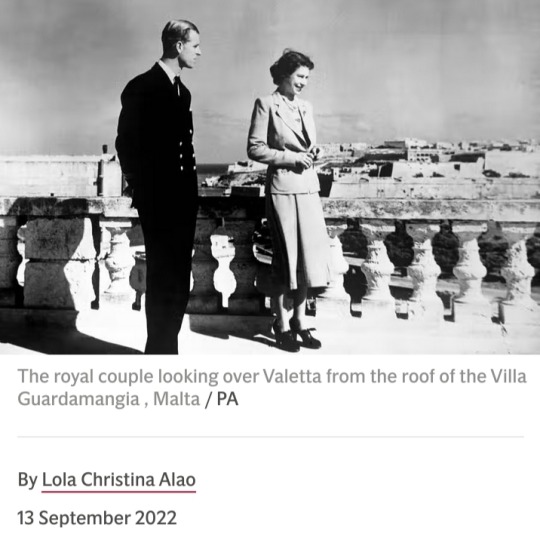
“Malta was always very special to me. I remember happy days here with Prince Philip when we were first married,” said the Queen in 2015.
Lady Pamela, who was one of the Queen’s bridesmaids, has also spoken of the love the late monarch had for the island.
“The Princess really loved Malta because she was able to lead a normal life, wander through the town and do some shopping,” she told MailOnline.
“It was the only place that she was able to live the life of a naval officer’s wife, just like all the other wives. It was wonderful for her and it’s why they have such a nostalgia for Malta.”
With 300 days of sunshine per year, and beautifully breathtaking landscapes that have served as locations for major film and TV productions such as Game of Thrones, Popeye, and Gladiator, it’s no surprise that the Queen was so fond of Malta.
The Queen’s love affair with Malta
The Queen and Prince Philip were married in November 1947 and spent their early years of marriage in Malta between 1949 and 1951.
They lived at Villa Guardamangia, owned by Philip’s uncle, Lord Mountbatten.
The Duke was stationed there as a naval officer and was appointed second-in-command of HMS Chequers, operating from Malta with the Mediterranean fleet.
The property offered the newlyweds more than just a Mediterranean base, as Malta gave them their only taste of real life and a place where they could be their normal selves.
In fact, Malta is the only place outside the UK that Queen Elizabeth has ever called home.

Hicks said:
“They were magical days of endless picnics, sunbathing, and water skiing. It was wonderful for her and it’s why they have such nostalgia for Malta.”
The Queen liked to divide her time between England – where she could spend time with her son, Charles, and his grandparents – and Malta.
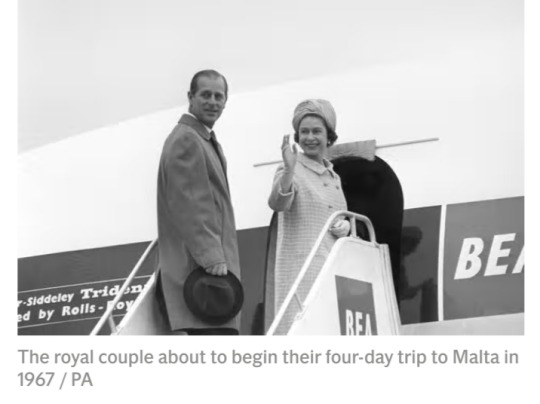
Elizabeth’s magical and carefree time in Malta allowed her to handle cash for the first time, drive through the narrow streets, and dance with Prince Philip in the ballroom of Hotel Meridien Phoenicia.
The Queen would also host tea parties and visit the local salon while Philip was on board Chequers.
In 1951, King George’s health deteriorated rapidly, and the couple had to make a return to normal life, moving back to the UK.
Prince Philip left the Royal Navy on “indefinite leave” in July 1951, ending his military career to stand by Elizabeth.
Following King George’s death on 6 February 1952, Elizabeth became Queen Elizabeth.
The Queen and the Duke of Edinburgh returned to Malta several more times.
In 2007, the couple celebrated their diamond anniversary in Malta and, most recently, in 2015, they were there for the Commonwealth summit in Valletta.
During the trip, former Maltese president Marie Louise Coleiro gifted the couple a watercolour of Villa Guardamangia.
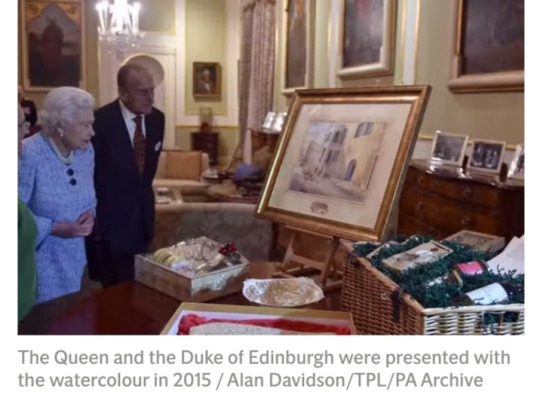
Now Villa Guardamangia, just outside Valetta, is set to be transformed into a museum, after falling into disrepair in recent years.
The planned restoration project is being managed by the Maltese government, which acquired the 18-bedroom property last summer, three years after its last residence.
An elderly woman who could no longer handle its upkeep previously lived there. It will see the former royal residence transformed into a museum for all to visit, exploring Britain’s link to Malta (which gained independence in 1964), and will recreate what the house looked like when The Queen and the Duke of Edinburgh lived there.

67 notes
·
View notes
Text
Philip wanted to sue The Crown after being blamed for sister’s death
Duke consulted royals’ favorite law firm after plotline left him ‘hurt and upset’
The Duke of Edinburgh spoke to his lawyers about suing Netflix over a false portrayal of him in The Crown that left him deeply “upset”.
Prince Philip consulted Farrer & Co, the blue-blooded law firm that has advised the royal family since the 1930s, after the series featured a plotline about the death of his older sister, Princess Cecilie.
Hugo Vickers, a royal historian and author, said: “I know Prince Philip consulted his lawyer about it, to ask ‘What can I do about it?’ He was very upset about the way that was portrayed. He was human. He could be hurt like anybody else.”
The plot features in the penultimate episode of the second series, which was first broadcast in 2017, without a fictional disclaimer. It includes imagined scenes in which Philip, then aged 16, is involved in a misdemeanour at his boarding school, Gordonstoun, resulting in him not being allowed to spend his half-term break in Germany with Cecilie, who is heavily pregnant with her fourth child. In the Netflix drama, she is depicted telling Philip she will consequently be forced to fly to London to attend a wedding with her family.
Cecilie, 26, the third of Philip’s four older sisters, was killed in a plane crash in November 1937 with her husband and their two young sons when their plane hit a factory chimney in fog near Ostend. She had given birth during the flight and her baby’s body was found alongside her in the wreckage.
In the Netflix dramatisation of Cecilie’s funeral, their father, Prince Andrew of Greece and Denmark, says to onlookers and a tearful Philip: “I’m surprised he dare show himself here. Had it not been for Philip and his indiscipline she would never have taken that flight. It’s true, isn’t it boy? You’re the reason we’re all here burying my favourite child. Get him out of here.”
However, her decision to travel to London had nothing to do with Philip, who was particularly close to Cecilie. Her death deeply affected him and in later life he recalled being summoned to his headmaster’s study and informed of her death: “I have the very clearest recollection of the profound shock with which I heard the news of the crash and the death of my sister and her family.”
While staying with the Queen and Philip, a close friend of the royal family said Philip had expressed anger at his portrayal. “I remember sitting next to the Duke of Edinburgh at a dinner, and him being so upset about it and what it [The Crown] was saying about him.”
Vickers, the author of The Crown Dissected, which sets out errors in the series, said: “[Philip] was not displeased when I put the record straight.” Philip chose not to pursue legal action and the long-held royal mantra of “never complain, never explain” prevailed.
It can also be revealed that the Prince of Wales believes The Crown is “damaging” to the royal family. A close friend of Prince William, who is played by the child actors Timothee Sambor and Senan West in the new series, said he found the fallout from the series increasingly difficult as the events portrayed come closer to the present day.
The friend said: “He has spoken about it, and now, as it is coming closer to the present, he is particularly concerned about it. William does think it is damaging. The royal family know a lot of it is nonsense, but it is really harsh and hurtful.”
The revelations give new insight into how personally wounding The Crown has proved for some members of the royal family, and how opposed their views are to those of the Duke of Sussex, who is working with Netflix on two projects as part of a his multimillion-pound deal.
In an interview with James Corden last year, Harry said the series was not “strictly accurate” but said it was “loosely based on the truth” and gave a “rough idea” of the pressures of royal life. He added that he is “way more comfortable with The Crown than I am seeing stories written about my family or my wife”.
(source)
35 notes
·
View notes
Text
The Mail: ‘The Crown’ is ‘lurid,’ portraying Charles as ‘devious, impatient, resentful’
November 01, 2022
By Kaiser

The British royal commentators are playing a dangerous game with Netflix, The Crown and the monarchy. Their gleeful commentary about the “lurid, unflattering” Netflix series shows their eagerness to exploit all of these tragedies all over again, all while assuming an air of performative fury on behalf of King Charles. Does Charles really understand what he’s unleashed? Netflix is laughing all the way to the bank, especially with Salt Island’s media giving The Crown millions in free publicity. Even more than the free publicity, the commentators are making The Crown sound like the most epic royal takedown ever. The Mail’s Christopher Stevens has seen the whole (still embargoed) season 5. And he couldn’t help but throw a huge tantrum about all of it.
There are no depths of bad taste that writer Peter Morgan does not plumb in the new ten-part series of The Crown on Netflix. Divorces, infidelities, the most intimate conversations, the infamous interview with Princess Diana and Martin Bashir, even the death of a five-year-old from cancer, all are exploited for lurid drama. As the eight-and-a-half hours of new film were made available to journalists last night, under a stringent embargo, the sheer virulence of the storylines became shockingly clear.
Charles, Philip and at times the Queen herself are portrayed with disdain bordering on mockery. A teenage Prince William is also shown in an unflattering light, as slightly dim and sulky, though his younger brother Harry is let off lightly and barely features. Netflix may well find that, with the international grief and mourning that marked the death of the Queen less than two months ago, viewers’ appetite for royal muck-raking has disappeared.
Insiders at the streaming video giant say the mood in the company is already uneasy, with some American executives surprised by the backlash from fans who fear the death of the Princess of Wales will be re-enacted in graphic detail. This series stops short of that moment. It ends with Diana, divorced from Charles, preparing for a Mediterranean holiday with her friend Dodi Fayed.
Full reviews, with assessments of individual performances and an analysis of how far the script strays from historical fact, are embargoed until Saturday morning. But no spoiler alert is needed when I say that this series of The Crown is unrecognisable in its tone, compared to the original series in 2016. This show with its almost unlimited budget and all-star cast has become a monstrous perversion of itself.
At the beginning, The Crown charted the affectionate romance of the Princess Elizabeth and her prince, the Duke of Edinburgh, played with touching vulnerability by Claire Foy and Matt Smith. But it has descended into scandal-mongering, intent on inflicting every possible embarrassment on the Royal Family. The Crown is now a nakedly republican polemic, using embarrassment as its chief weapon against the monarchy.
Chief victim is the monarch himself. Perhaps Morgan and his Netflix paymasters imagined, like most of us, that the Queen would survive, ruling above reproach, for a number of years to come – and that the Prince of Wales was fair game. Certainly, none of the preview episodes (labelled, it ought to be said, as ‘work in progress’) carried an acknowledgment of Her Majesty’s death. Any viewers expecting a respectful caption, saluting her 70 years on the throne, will be disappointed.
But from the outset, the campaign against Charles is lacerating. In scene after scene, he is depicted as devious, impatient, resentful, devoid of self-awareness in his desperation to be king. This prince is a plotter whose mind works constantly, even during holidays with friends, on ways to dislodge his mother and force her aside. His aides talk of little else.
Charles and Camilla Parker-Bowles – now the King and Queen Consort, a fact shamefully ignored by Netflix – suffer greater indignity still, with the replay of that excruciating phonecall. Dominic West as Charles and Olivia Williams as Camilla, then his married mistress, re-enact every word of it… including that awful extended metaphor about being reincarnated as a tampon. It is performed without mercy, and to emphasise the humiliation we see the reaction of other royals when the transcript is published. Princess Margaret reads it in bed. Diana holds her head in her hands.
[From The Daily Mail]
Charles “is depicted as devious, impatient, resentful, devoid of self-awareness.” “The Crown is now a nakedly republican polemic, using embarrassment as its chief weapon against the monarchy.” DON’T THREATEN ME WITH A GOOD TIME!!! Omg, I was genuinely worried that Peter Morgan was going to soft-pedal some stuff but I guess not! Apparently, Diana’s Panorama interview stretches over two episodes, which is pretty fair – it was the biggest f–king thing to happen to the monarchy in decades. I love all of the agitation about “they didn’t acknowledge that Charles and Camilla are king and queen now” and “they didn’t acknowledge QEII’s death!!” My dude, this is a dramatization of what happened in the ‘90s, not a documentary. In fact, the monarchy has run a huge campaign against the Crown to emphasize that it’s not a documentary. Anyway, one more week!!!
-
yay this sounds fab!

#prince charles#the crown#the crown season 5#camilla parker bowles#princess diana#diana princess of wales#celebitchy
53 notes
·
View notes
Note
Laughing my ass off at the Wales Wailers who think William or George will bring back the coronets, robes for all, and all the pageantry back same as Elizabeth 's coronation 😂😂. They'll be lucky if William doesn't decide to let go of the coronation and simply have a concert of something. And George's coronation/reign? Yeah let's not even go there. All three of the Wales kids have already been put on mile long pedestals. People keep in forgetting the huge controversies that Edward and Anne caused in their younger years. Those days are forgotten now, but it's far more difficult to forget the scandals now in the age of social media. Keep on dreaming.

It's even funnier when you read Roya Nikkhah's article in The Times this weekend:
A source close to William said: “There is no way he will go down that route or anything like it.”
William, 40, who paid a poignant “homage of the blood” to Charles, 74, during the coronation, kneeling before his father and swearing to be his “liege man of life and limb”, has been carefully “reflecting” on the events of last week with his closest friends and advisers.
A source close to the prince said: “He is really thinking, how do we make his coronation feel most relevant in the future? He is mindful of the fact that in 20 years’ time, or whenever his time comes, how can the coronation be modern but also unifying to the nation and the Commonwealth? I think his coronation will look and feel quite different.”
The source added: “Are courtiers sitting at Kensington Palace coming up with a grand plan about what the next Bridge will look like [London Bridge was the codeword for the late Queen’s death, and Forth Bridge for Prince Philip]? No.
“But of course the prince and his team are reflective about the events of last week and it is extremely important to him that it evolves to be relevant whenever it happens.”
It is understood that, contrary to some reports, William was not closely consulted on the planning for Charles’s coronation. The prince, who will be known as King William V, is thought to be committed to being crowned at Westminster Abbey, where every British monarch’s coronation has been held since William the Conqueror’s in 1066.
But those close to him point to his decision not to have an investiture as Prince of Wales as an indicator of how William will continue to break with tradition as heir to the throne. In July 1969, Charles had a coronet placed on his head by his mother in a ceremony at Caernarfon Castle in north Wales that looked medieval in parts.
William is going to trim that coronation ceremony down to an hour. Eliminate all the great music that was in Charles' coronation. It's going to be a quick & stale ceremony. Just say the bare minimum of liturgy, put the crown on, and walk out with the national anthem. That's it.
Actually, I do have better hopes for George's coronation as he seems to have a bit of an artistic streak, which William most definitely does not have.
Also, note the "source close to the prince" who mentioned "in 20 years' time." This is why William is so slow to prepare himself for becoming king. He figures he has another twenty years to prepare for being king. This is why he's in no rush to do regular royal work. He figures he can push it, and everything else he doesn't like to do down the road.
#ask#operation golden orb#Wales Wailers#crazy cambridge stans#William The Prince of Wales#roya nikkhah
10 notes
·
View notes
Text
Sophie, Countess of Wessex to gain new title if Edward becomes Duke of Edinburgh
It may be considered a final, poignant nod to the daughter-in-law who called her “Mama”.
Queen Elizabeth II’s title of the Duchess of Edinburgh will pass to the Countess of Wessex if, as expected, Prince Edward succeeds his father as the Duke of Edinburgh.
Such a move would elevate the status of the Countess at a time when her role becomes notably more significant - one of just a handful of working royals in the new, slimmed down monarchy.
The decision rests in the hands of the King, who has held the title ever since his father’s death.
However, the late Prince Philip had made his wishes clear: when the time comes, his youngest son should be given the title. Prince Charles was said to agree and the deal was all but rubber stamped.
Duke of Edinburgh title 'will not go to Edward'
Last year, following the Duke’s death, speculation swirled that Charles had had a change of heart.
One source told the Sunday Times: “The Prince is the Duke of Edinburgh as it stands, and it is up to him what happens to the title. It will not go to Edward.”
Even the Earl, the only one of the late Queen’s three sons who does not have a Dukedom, appeared to be having doubts, telling the BBC in an interview: “It was fine in theory, ages ago when it was sort of a pipe dream of my father’s... and of course it will depend on whether or not the Prince of Wales, when he becomes king, whether he’ll do that, so we’ll wait and see. So yes, it will be quite a challenge taking that on.”
But experts believe it likely that the title will eventually be passed to the Earl, who has already taken on the responsibilities associated with his father’s hugely successful Duke of Edinburgh Award scheme.
To do so, a new dukedom of Edinburgh would have to be created by letters patent but such a move is not unprecedented. The gesture would provide a fitting link between the late Queen and her daughter-in-law.
Their relationship may have blossomed behind closed doors but few this week can have been left in any doubt about the close bond between the two.
The depth of the Countess’s grief has been plain to see; as she crouched, ashen faced and red-eyed, to view flowers at Balmoral on Saturday and when she gazed from the car window, lost in thought, during the procession from the Palace of Holyroodhouse to St Giles’ Cathedral on Monday.
Queen treated Sophie 'like a second daughter'
When the devastated Princess Royal dropped to a deep curtsy as the late Queen’s coffin was carried past her into the cathedral, it was the Countess whose arm was outstretched in support. That brief human touch said more than a thousand words.
Sophie, 57, had grown so close to the late Queen that she is said to have been treated like a “second daughter”.
It was when she lost her own mother, Mary Rhys-Jones, to stomach cancer in 2005 at the age of just 71, that their relationship flourished, as the Queen provided much needed support and solace.
The Wessex family home, Bagshot Park, is just a few miles from Windsor Castle, enabling the whole clan to spend many precious hours in the company of the Queen and Prince Philip.
Sophie and the late Queen are said to have shared a love of military history and enjoyed poring over documents in the Royal Archives at Windsor.
When her busy diary did not allow her to visit in person, she made sure to contact the Queen by telephone daily.
The Countess was the first member of the Royal family to speak publicly about the death of Prince Philip last April, a sign of the level of trust and affection with which she had come to be regarded.
When coronavirus restrictions were eased, it was the Countess who would often join the monarch for walks around the Windsor estate.
The Oxford-born former PR girl is one of a small coterie of senior royal women on whom the future of the monarchy now rests.
Through sheer hard work and loyalty to the Crown, she has gradually become one of the most pivotal members of the family, a safe pair of hands who works tirelessly behind the scenes.
It is to Sophie who the new Princess of Wales is said to turn for advice, having watched her successfully balance royal duties with the care of her two children, Lady Louise, 18, and James, Viscount Severn, 14.
Rather than take up fashionable causes, she has worked with sexual violence victims, travelling to counties affected by conflict including South Sudan and Sierra Leone.
She works in other fields to promote women, having founded the Women’s Network Forum in 2014 which she chairs, and bringing together a cross-industry group of senior figures to promote gender balance and equality in the workplace.
Her daughter’s sight problems as a child inspired her to campaign for several charities for the blind and visually impaired.
By taking on the Duchess of Edinburgh title, Sophie will raise her profile further. The Queen now gone, she is rapidly becoming an integral part of the future Firm.
source: https://www.telegraph.co.uk/royal-family/2022/09/13/sophie-wessex-gain-new-title-edward-becomes-duke-edinburgh/
#prince edward#sophie wessex#duke of edinburgh#british royal family#duchess of edinburgh#queen elizabeth#prince philip
25 notes
·
View notes